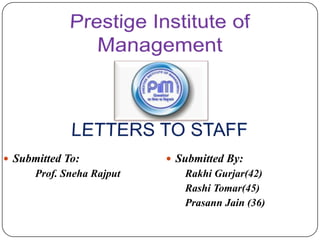
Internal Communication Forms Guide
- 1. Submitted To: Submitted By: Prof. Sneha Rajput Rakhi Gurjar(42) Rashi Tomar(45) Prasann Jain (36)
- 2. Internal Communication Interactions between members of the same organizations is called “Internal Communication”. It’s concerned with the transmission and reception of information, orders, suggestions, warnings etc. with in the organization.
- 3. Forms of Internal Communication Letters to staff Circulars Memos Office Note or Notice Representations and Suggestions Motivational Communication Letters from Top Management Reminders and Follow up Employees News Letters
- 5. Types of letters to Staff and Employees Letter of Recommendation Letter of Reprimand (Warning) Letter of Complaint Letter of Nomination Letter of Suspension Letter of Sympathy or Condolence Employee Termination Letter Letter of Apology
- 6. Letter of Recommendation It provides evidence that letter’s author(employer) was satisfied with the project, product service or performance of a person (employee). It is used as a reference for Job application. When preparing the LOR, specific examples which illustrate, the worth of the person, should be included.
- 7. Do’s and Dont’s of LOR Be clear and concise with your writing. Avoid short letters of only one or two small paragraphs. Avoid lengthy letters with run on sentences. Make your letter persuasive and to the point. Mention concrete examples to support your recommendation.
- 8. Letter of Reprimand (Warning) Given to the employee as a means of rebuke (showing disagreement) towards unacceptable behaviour. It should be signed by the supervisor as well as employee. It is to be given to the employee along with one copy (each) to be placed in the official employee file, personnel officer and to the union (if applicable) respectively.
- 9. Information necessary in a LOR There should be a written notice of infraction, citing specific rule and policies violated. The letter should contain specific information regarding the unacceptable behaviour or performance. It should include grievance or appeal right. To improve employee performance, employer should know expectation from the employee.
- 10. Letter of Complaint • A LOC intended for a subordinate can be a sensitive matter. As a superior, you may be unfairly judged. • The LOC (if written carefully and respectively) can produce positive outcome. • The subject of this letter may be the sloppy work execution, habitual tardiness or absenteeism or misbehavior of the employee under you (superior). • It can be used as a clean way of effectively giving orders that can help, correct the situation or introduce positive change on part of the subordinate.
- 11. Letter of Nomination Letters of Nomination who have shown enthusiastic and consistence participation in company operations can help ensure their meaningful recognition. It is good to include an introductory statement or summarizing theme to reinforce the point of the letter, to persuade persons in position of judges to select the nominated workers.
- 12. Letter of suspension Fair labor Standard Act (FLSA) covers the disciplinary suspension for employees. If an employee exempt from the FLSA, he will be given documentation of disciplinary action which would be equitant to a paper suspension. It can not exceed 30 days. Employee can be removed from the workplace on the basis of the outcome of an investigation dealing with suspension.
- 13. Letter of Sympathy or Condolence Condolence letters are written on the very unfortunate incident of death of any relative or known person. These letters should be short and sincere. It should be hand written on standard stationary or on corporate letter head paper.
- 14. Employee Termination Letter A company has its own rules and policies that the employee should follow. If not followed, the employer have right to implement disciplinary measures and termination, if needed. It should include the exact reason for firing the employee. It should be written in a polite language and should show that you are concerned with your employee future endeavors and well being.
- 15. Contd… It should begin with a brief statement of sympathy such as “I was deeply sorry to hear of loss”. In middle, mention the good qualities or the positive contribution made by the deceased. In closing, you can offer your condolences and your best wishes.
- 16. Letter of Apology In business, there are instances, where the business does not perform well which ultimately may lead to close down. It becomes very upsetting and crucial to pass on this information to your employees. The employer should be sensitive when he writes this letter to his employees. Rule of KISS/CC should followed.
